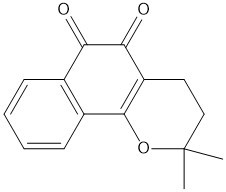ß-Lapachone | Topoisomerase-1 inhibitor
NMR (Conforms)

Available Options
| Size: | Price | Quantity | |
|---|---|---|---|
| 5 mg | $52.00 | ||
| 25 mg | $200.00 |
β-Lapachone (4707-32-8) is a naturally occurring quinone found in the bark of the Lapacho tree (Tabebuia avellanedae). A novel DNA topoisomerase I inhibitor which unlike camptothecin does not stabilize the cleavable complex indicating a novel mode of action.1 Induces apoptosis in a number of cancer cell lines.2 In cancer cells over-expressing NAD(P)H:quinone oxidoreductase, reduction of β-lapachone leads to futile cycling between quinone and hydroquinone forms3 resulting in the production of reactive oxygen species4. Suppresses radiation-induced activation of NFκB.5
References/Citations:
1) Li et al. (1993), beta-Lapachone, a Novel DNA Topoisomerase I Inhibitor With a Mode of Action Different From Camptothecin; J. Biol. Chem., 268 22463
2) Wuerzberger et al. (1998), Induction of Apoptosis in MCF-7:WS8 Breast Cancer Cells by Beta-Lapachone; Cancer Res., 58 1876
3) Pink et al. (2000), NAD(P)H:Quinone Oxidoreductase Activity Is the Principal Determinant of Beta-Lapachone Cytotoxicity. J. Biol. Chem., 275 5416
4) Siegel et al. (2012), NAD(P)H:quinone Oxidoreductase 1 (NQO1) in the Sensitivity and Resistance to Antitumor Quinones; Biochem. Pharmacol., 83 1033
5) Dong et al. (2010), Beta-lapachone suppresses radiation-induced activation of nuclear factor-kappaB; Exp. Mol. Med., 42 327
NMR (Conforms)
Safety Data Sheet:
Product Data Sheet:
Materials provided by Focus Biomolecules are for laboratory research use only and are not intended for human or veterinary applications. Please note that we do not sell to individuals and that all orders placed by non-research organizations will incur a $20 restocking/refund fee
β-Lapachone (4707-32-8) is a naturally occurring quinone found in the bark of the Lapacho tree (Tabebuia avellanedae). A novel DNA topoisomerase I inhibitor which unlike camptothecin does not stabilize the cleavable complex indicating a novel mode of action.1 Induces apoptosis in a number of cancer cell lines.2 In cancer cells over-expressing NAD(P)H:quinone oxidoreductase, reduction of β-lapachone leads to futile cycling between quinone and hydroquinone forms3 resulting in the production of reactive oxygen species4. Suppresses radiation-induced activation of NFκB.5
References/Citations:
1) Li et al. (1993), beta-Lapachone, a Novel DNA Topoisomerase I Inhibitor With a Mode of Action Different From Camptothecin; J. Biol. Chem., 268 22463
2) Wuerzberger et al. (1998), Induction of Apoptosis in MCF-7:WS8 Breast Cancer Cells by Beta-Lapachone; Cancer Res., 58 1876
3) Pink et al. (2000), NAD(P)H:Quinone Oxidoreductase Activity Is the Principal Determinant of Beta-Lapachone Cytotoxicity. J. Biol. Chem., 275 5416
4) Siegel et al. (2012), NAD(P)H:quinone Oxidoreductase 1 (NQO1) in the Sensitivity and Resistance to Antitumor Quinones; Biochem. Pharmacol., 83 1033
5) Dong et al. (2010), Beta-lapachone suppresses radiation-induced activation of nuclear factor-kappaB; Exp. Mol. Med., 42 327
Calculate the molar concentration, mass or volume in a solution.
Concentration × Volume × Molecular Weight = Mass
Focus Biomolecules • Plymouth Meeting, PA USA • 1-855-FOCUS21
Focus Biomolecules
Plymouth Meeting, PA USA
1-855-FOCUS21
Website Created by Advanta Advertising LLC.

